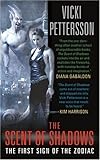Some friends of mine loaned me some books to read recently, since they both know I’m a fan of urban fantasy. I rather enjoyed the books, overall, and I’m pleased one of the books turned me on to a series which I think will be worth following. The books were Patricia Briggs’ Moon Called (Mercy Thompson, Book 1), Lori Devoti’s Amazon Ink, Greg van Eekhout’s Norse Code, Cathy Clamp & C.T. Adams’ Touch of Evil (Thrall, Book 1), and Vicki Pettersson’s The Scent of Shadows (Sign of the Zodiac, Book 1). Here’s my quickie reviews of all five — but first, two caveats:
a) I’m a harsh reviewer, so take this with a huge grain of salt! and…
b)There will be spoilers in this review.
I listed the books above in the order I read them, so I’ll review them in reverse order — mostly because that way I’m reviewing the books freshest in my memory first. I read these books in a week, so I’ve still got all the information to mind, and I want to get it all out before I forget it. While I often list mostly what I didn’t like, I’ll reiterate: the books were good brain candy, and overall I enjoyed them. Also, fair warning once more:
There ARE spoilers in these reviews!
The Scent of Shadows
This was perhaps the least “urban fantasy” of all five books. It was instead a book about superheroes — right down to sort-of secret identities — with a Zodiac motif, and conveniently arranged into a Light side and a Dark side. It had a few “gotchas” I noticed, although they weren’t enough to diminish the story. For example, at one point our heroine is trapped in a convenience store where she sees there is no back door — but shortly thereafter, once her allies appear, she hears the back door open, then slam, as the villain makes good his escape. That did not unduly worry me, since the motif of the villains is “smoke and mirrors.” However, I did find another occurrence within the story to be a definite misstep: the heroine is informed none of the bad guys would dare harm any who “belong” to the lead bad guy’s foremost henchman. If this is the case, why was the henchman’s daughter murdered by the bad guys?
Curiously, the complete surgical body change our heroine endured (performed without her permission, which is a huge bugaboo for me) was given quite short shrift, and I found that rather unbelievable. Like the heroine in her original form, I am not at all “girly,” and I can assure you behaving that way is neither easy nor natural — it must be learned over time, like any other habit unnatural to you. Further, going from a slender, muscular, trim body type to a voluptuous, buxom, shorter woman should (I think) make quite a difference in how one performs martial arts. To have the heroine shift smoothly from one body type and personality to another as swiftly and cleanly as she did… painfully snapped my suspenders of disbelief.
I found myself also somewhat perplexed both with some of the assumptions of the story, and the sheer number of unanswered questions at the end. I understand the author wishes to have things for the heroine to discover in future books, but as a single example, why was no one worried about how the Dark/Light comics creators were getting their (completely accurate!) inside information? Also, so what if a Darksider cannot touch a Lightsider comic, or vice versa? Just get a normal human to hold them for you — or use a long tweezers!
Further, if the Lightside Zodiac warriors were strictly of matriarchal descent, and males were inducted only if all their female siblings were deceased — then why were there so many male Lightside Zodiac warriors? I kept track through the story, and of the ones met, five were male (one a child) and three were women (one mad). That means there are four missing (we know one is captured) or dead — so even if all of them were female (which is never stated), that’s still a significant percentage of males. If the implication meant by the author is that women aren’t up to the rigors of the job, then I’m even less impressed.
The author writes quite evocatively, and plays with the conventions of the “classic” murder mystery such that you find yourself unsure who the traitor is for quite some time. Unfortunately, while the story was well written and exciting, it did not leave me wanting to read the next books in the series. I love good superhero stories, but one of the things I love about them is the trope of the heroes being more than just straightforward murderers. You are, admittedly, given every encouragement to believe the practically demonic Dark side of the Zodiac well deserves death — but again, I prefer a slightly more nuanced separation of the good guys and the bad guys.
